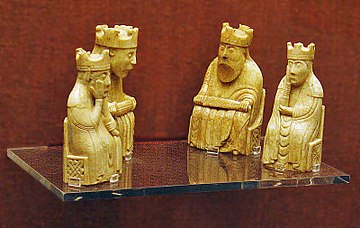| Lewis chessmen | |
|---|---|
 Lewis chessmen in the British Museum | |
| Material | Walrus ivory and whales' teeth |
| Created | 12th century |
| Discovered | 1831 Uig, Lewis, Scotland |
| Present location | |
| NMS website entry | |
The Lewis chessmen (Scottish Gaelic: Fir-thàilisg Leòdhais [fiɾʲˈhaːlɪʃkʲ loː.ɪʃ]) or Uig chessmen, named after the island or the bay where they were found,[1] are a group of distinctive 12th century chess pieces, along with other game pieces, most of which are carved from walrus ivory. Discovered in 1831 on Lewis in the Outer Hebrides of Scotland,[2] they may constitute some of the few complete, surviving medieval chess sets, although it is not clear if a single complete period-accurate set can be assembled from the pieces. When found, the hoard contained 94 objects: 78 chess pieces, 14 tablemen (pieces for backgammon or similar games) and one belt buckle. Today, 82 pieces are owned and usually exhibited by the British Museum in London, and the remaining 11 are at the National Museum of Scotland in Edinburgh; one chesspiece is owned privately.[3][4]
The newly identified piece, a "warder", the equivalent of a rook, was sold for £735,000 in July 2019. Four other major pieces, and many pawns, remain missing from the chess sets.[4]
- ^ "Comann Eachdraidh Ùig" [Uig chessmen]. Ceuig.co.uk (in Scottish Gaelic). Retrieved 24 March 2017.
- ^ "The enigma of the Lewis chessmen". Chessbase.com. 9 November 2010. Retrieved 15 August 2013.
- ^ Cite error: The named reference
BBC-2019-06-48494885was invoked but never defined (see the help page). - ^ a b "Lost Lewis Chessman piece bought for £5 sells for £735,000 at auction". BBC News. 2 July 2019. Retrieved 12 July 2021.